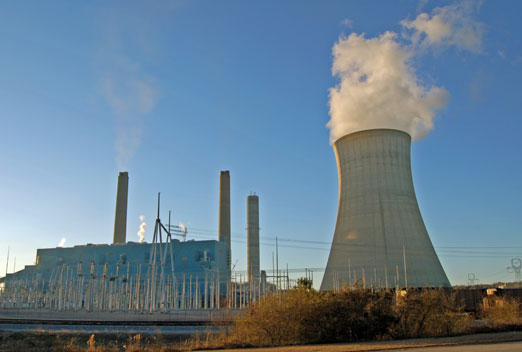
Alabama Power’s Miller Steam Plant on the Locust Fork of the Black Warrior River emits more mercury into the air than any other power plant in the country. It is also a source of fine particulate pollution and ozone, which cause the Ozone allergy or the Ozone Flu: Glynn Wilson
New standards would reduce hazardous air pollutants from coal-fired power plants, further protect public health and advance environmental justice –
Staff Report –
WASHINGTON, D.C. — The Biden administration released a set of proposed new pollution standards on Wednesday to update the Mercury and Air Toxics Standards for coal-fired power plants, advancing tougher requirements to reduce hazardous air pollutant ion emissions and further public health protections for the public, especially children and vulnerable segments of the population such as Indigenous communities, low-income communities and people of color who live near power plants.
The Environmental Protection Agency (EPA) released the new rules for public comment, calling it the most significant update since the so-called MATS rules were first issued in February 2012. It fulfills EPA’s responsibility under the Clean Air Act to periodically review emission standards as required by law and the courts. Earlier this year EPA reaffirmed the scientific, economic, and legal underpinnings of the standards, reversing a rule issued by the Trump administration that undermined the legal basis for these vital health protections.
“America is leading the way in innovation, and our work to protect public health is no different. By leveraging proven, emissions-reduction measures available at reasonable costs and encouraging new, advanced control technologies, we can reduce hazardous pollution from coal-fired power plants, protecting our planet and improving public health for all,” EPA Administrator Michael S. Regan said in making the announcement.
“Today’s proposal will support and strengthen EPA’s Mercury and Air Toxics Standards, which have delivered a 90 percent reduction in mercury emissions from power plants over pre-standard levels, ensuring historic protections for communities across the nation,” he said, “especially for our children and our vulnerable populations.”
MATS requires significant reductions of mercury, acid gases, and other harmful pollutants from coal and oil-fired electric generating units. After reexamining the previous administration’s required review of MATS, EPA is proposing more stringent emissions limits and additional, cost-reasonable monitoring and control methods to further reduce harmful pollution from these sources, resulting in cleaner air for surrounding communities.
EPA projects that the proposed rule would reduce emissions of mercury and non-mercury metal pollution, such as nickel, arsenic, and lead. These pollutants are known to cause significant health impacts including fatal heart attacks, cancer and developmental delays in children. The proposal would also result in emissions reductions of fine particulate matter, sulfur dioxide, nitrogen oxides, and carbon dioxide nationwide.
Based on its latest assessment of available control technologies and techniques for reducing hazardous air pollutant emissions, EPA is proposing to further reduce – by 67 percent – the emissions limit for filterable particulate matter (fPM) for existing coal-fired power plants. This standard is designed to control emissions of nickel, arsenic, and other non-mercury HAP metals from these plants. The proposal also includes cost and feasibility information on achieving even lower levels of fPM emissions, and EPA is taking comment on whether to finalize a more stringent standard.
In addition, EPA is proposing a 70 percent reduction in the emissions limit for mercury from existing lignite-fired sources, a limit that would ensure these plants achieve the same level of emissions performance as other coal-fired power plants. Mercury exposure at high levels can harm the brain, heart, kidneys, lungs and immune system of people of all ages.
EPA’s proposal also includes improvements and updates to emissions monitoring requirements for coal-fired power plants by requiring continuous emission monitoring systems to comply with the revised fPM emission limit. These continuous monitoring systems are highly cost-effective devices that provide regulators, the public, and facility owners or operators with accurate and real-time emission measurements. This up-to-the-moment, quality-assured data can lead to improved control device and power plant operation, reducing air pollutant emissions and exposure for local communities.
EPA is also proposing to revise requirements related to startup provisions to assure better emissions performance during periods of startup.
EPA’s proposal projects net public health benefits over the 10-year period from 2028 to 2037 to be $2.4 billion to $3 billion. This includes $1.2 billion to $1.9 billion in health benefits, along with projected compliance costs of $230 million to $330 million. EPA estimated health benefits, compliance costs and net benefits of the proposed revisions to the MATS rule as directed by Executive Order 12866.
These proposed revisions build on the highly successful and cost-effective protections in the current MATS rule. MATS, combined with technological advancements in the power sector, has driven sharp reductions in harmful pollutants. Industry-reported emissions data, required by MATS, show that 2021 mercury emissions from coal-fired electric generating units are 90 percent lower than pre-MATS levels.
EPA’s proposal is aligned with the Biden-Harris Administration’s whole-of-government commitment to environmental justice and Administrator Regan’s commitment to transparency for the power sector as the agency works to protect communities from the impacts of power plant pollution. This proposal provides regulatory certainty that allows states, grid operators, and power companies to make investments and planning decisions, while preserving the industry’s ability to deliver reliable and affordable electricity.
EPA is requesting public comment on all aspects of this proposed rule, including the evaluation of the costs and efficacy of control option assumptions. EPA will accept public comment on the rule for 60 days after publication in the Federal Register. EPA also plans to hold a public hearing.
Details will be available on the EPA website under Mercury and Air Toxics Standards.













